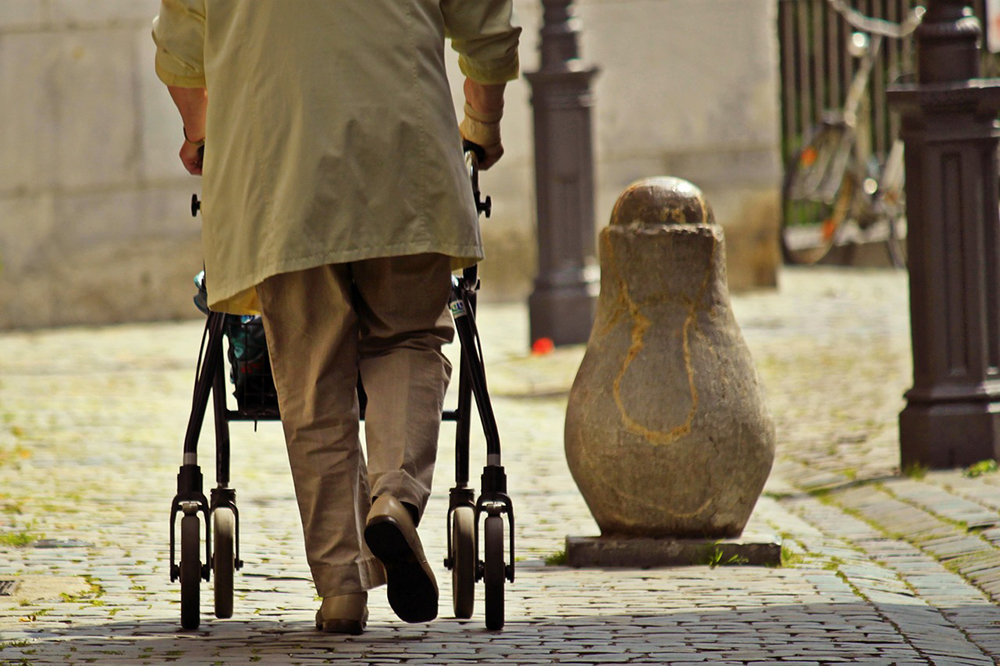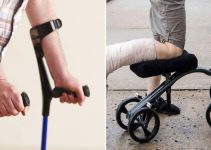Walkers are essential equipment for the elderly and other people with mobility problems such as individuals recovering from injury or with disabilities. However, what is unknown to many people is that there are different types of walkers for elderly on the market today.

A walker is an ideal mobility aid, especially for people with balance-related concerns as it supports more weight than other mobility aids such as a cane for balance problems. Therefore, the best type of walker to choose for your loved ones should be a mobility aid that provides optimum stability.
However, choosing the type of walker for elderly that meets your needs can be a considerable challenge as there are many options available. It is also important to understand that mobility aids come in different styles that may or may not offer what you or your loved one needs.
For instance, some of the walking aids feature designs that prevent potential falls and slips while others are ideal for places with limited space. Consequently, it is advisable to understand your physical condition when looking for a walker to ensure that you get the right product. Here we look at the types of walkers as well as how to choose it, which will make it easier for you to find the right one.
Types of Walkers
As mentioned above, there are different types of walkers and what you might not have realized is that the right model for you or your loved one will not be necessarily good for another individual. However, before we look at the factors that determine the right type of walker for you, it is good to look at the different types available to you. These include:
Walking Frames or Standard Walker
Walking frames are mainly known as a standard walker and are the most popular type of walker. These walkers are durable and lightweight, which explains why they are ideal for indoor surfaces. Standard walkers offer maximum support to individuals with mobility issues as their design feature four non-wheeled legs.
Besides, using this walker is also quite easy, as the user is required to pick up and place it a short distance ahead, then takes a few quick steps forward before moving the walker a few inches again.
However, for some users, these walkers may be too slow, but they are stable and supportive, which reduces risks of falls or slips. If you are looking for this type of walker, we recommend the Drive Medical 10200-1 Deluxe Two Button Folding Walker .
Wheeled Walker
#Affiliate links.Last update on 2024-04-24 at 19:51
Wheeled walkers is an improvement to standard walkers as it allows you to move it ahead as you walk without necessarily picking it up. The walker comes with two wheels on the front, which enables you to move the mobility aid forward before taking a few steps towards it and then moving it again. Moreover, the two wheels on the front do not compromise on the stability of the mobility aid as it back two legs have rubber stoppers. With the great design, the wheels also enable the user to traverse uneven terrain easily.
However, it is good to understand that these walkers are not ideal for places with limited space. Thus, they are not perfect for indoor use. It might also prove difficult to use the walker in place with carpet, as the wheels may not glide with the much-needed ease.
For wheeled walkers, we like the Deluxe Two Button Folding Walker with 5-Inch Wheels, as it is easy to fold and pack when not in use or to store on the trunk of the car when traveling. Besides, the walking aid also has several excellent reviews as compared to most of the products in its level.
4 Wheel Rollators and 3 Wheel Rollators
#Affiliate links.Last update on 2024-04-24 at 18:21
These refer to types of walkers with wheels on all the legs. The mobility aid equipment provides the best in movement and mobility because of its wheels, which are mainly able to swivel. A rollator may include additional features such as seats and even carrier baskets to allow the user to sit when necessary and go on a long walk.
On the other hand, a basket aid adds more independence to your walker as it allows you to take some of the necessities with you, without requiring the services of a caregiver.
When choosing a rollator, it is good to understand that 4 wheeled walkers offer greater stability, but 3-wheeled rollators provide more maneuverability and are lighter than their counterparts. Rollators are more suitable for people who are always on the go as it allows you to move at a much natural pace than other walkers. However, it is less stable than a wheeled walker or standard walker.
Knee Walkers
#Affiliate links.Last update on 2024-04-24 at 18:21
If you are looking for a type of walker that will allow you to walk comfortably and safely without putting too much weight on either of your legs, then a knee walker is an excellent option. A knee walker is an ideal type of walking aid for people recovering from injury or individuals who have had surgery.
This type of walker is designed with four wheels and resembles a bike. It also includes a cushioned area that allows the user to place his or her knee while using the other leg to propel them and move around. A knew walker is suitable for individuals with:
- Knee issues
- Ankle problems
- Surgery
- Hip issues
Therefore, these models are mainly designed for temporary usage, usually to allow users to recover from injuries. We highly recommend KneeRover Economy Steerable Knee Walker, if you are looking for a knee walker, as it is extremely lightweight and thus very maneuverable.
Narrow Walkers
#Affiliate links.Last update on 2024-04-24 at 15:55
Narrow walkers are specially designed walkers for seniors or individuals who live in small spaces. In addition, If you have to negotiate small entrances or walkways frequently, a narrow walker would be an idea choice as well.
Petite Walkers
#Affiliate links.Last update on 2024-04-24 at 16:16
Petite walkers usually provide a smaller height that enables smaller individuals with mobility issues to reach the handles easily. This explains why these walkers offer a better alternative to individuals that are vertically challenged.
How to Choose a Walker for Elderly and Seniors
The objective of choosing a particular type of walker for elderly is to ensure that you find a product that meets your needs and makes you or your loved one more independent. Besides, the ideal types of walkers for seniors should be able to enhance autonomy, keep balance, improve quality of life and increase the safety of the elderly individuals with limited mobility.
There are many types of walkers available in the market, which might make it hard for you to find the right mobility aid. Fortunately, there are some tips and factors that can significantly help you determine an ideal type of walker for elderly and seniors with great ease while also saving time. These include:
- Folding Option
The most important features to consider in a walking aid is whether it offers a folding option. Most walkers are cumbersome as they lack the folding feature that would make it the life of the elderly more comfortable and independent. Therefore, if you are an individual who travels or gets out of the home frequently, it is recommended to pick a folding model. Remember a folding mobility aid can be stored in the car trunk with great ease or in the backseat when traveling. You may also want to know more about the foldable electric scooter or folding electric wheelchair.
- Poor Balance
As mentioned earlier, it is essential to consider your strengths and weakness when looking at the right type of mobility aid. For instance, if you are an individual with precarious balance and thus cannot stand well independently, then a standard walker would be an excellent choice. Standard walkers allow the user to regain their balance while walking as they require the user to lift them off the ground and place them on it before moving it again. However, individuals with shoulder injuries may find them unsuitable for them, as it would be difficult to move them.
- Moderate Balance
A wheel or standard walker will be ideal for a person who has a reasonable balance when standing. However, a wheeled mobility aid may be perfect for such individuals walking on uneven terrain, though these people may lose balance if they exert too much pressure on the wheels.
- Good Balance
If you are a person with a good balance, you may do well with a rollator as compared to other types of walkers. Rollators move much faster around the ground than other mobility aids, which allows the user to walk faster and they are also ideal for all-around usage. Unfortunately, a rollator may not be the safest type of walker available as the user can easily lose balance making it difficult to stop it, which increases the risk of falls and slips. For seniors who have relatively good balance ability, a cane with seat may provide enough support already.
- Weight
The weight of the walking aid is another factor that cannot be overlooked, as it affects the user’s experience and level of independence. Choosing a durable and lightweight walker means that it can easily be transported and also withstand being used on uneven surfaces. In addition, for people with larger weight, you should look at the weight capacity of walker when buying it.
- Active Individuals
In most cases, a rollator walker is more suitable for active individuals. The walking aid includes a seat and a basket, which means that a person can walk longer and take a rest whenever necessary and also allows them to carry things, thus enhancing their independence. Moreover, it is also possible to find standard and specialty models that come with seats, but they are more difficult to find as compared to rollators.
How to Use a Walker
It is good to understand that a traditional walker is designed to offer support and stability while walking, this means that the user should ensure that the walker is stable and of a perfect height always to avoid accidents. Besides, choosing a walker with an ideal design for your mobility needs is the key to ensuring that benefit from your walking aid in the end.
If you are using a standard walker, it is also advisable to ensure that the mobility is firmly rooted on the ground before you make any movements. Moreover, you should also stand at the center of the walking aid with your hands on the side and ensure that your body is at the right position before you make in movements to avoid slips and falls.
Next, lift your walker and push it forward before making a movement by moving your weakest foot first. You can then move the strongest foot once you the walking aid is firmly rooted on the ground again. Following this procedure helps all your body weight does not entirely fall on the weakest foot at any point of your walking but on the strongest foot.
With enough practice, walking with normal walkers can be straightforward and entirely fall into habit, making it appear as a natural activity. Besides, using walkers as a mobility aid is ideal for people of all sizes and ages, who need some extra support and stability while walking around the home or grocery trips.
Using traditional walkers without wheels or any other add-ons comes with an added advantage, as they are commonly available on the market making them relatively cheaper. However, it is advisable to consult your physician or doctor to help you pick the right walker as choosing the wrong walking can aggravate your mobility issues.
Final Thoughts
Overall, finding the right type of walker can be a daunting task due to the number of products available on the market and factors to put into consideration. It also a delicate process as purchasing the wrong type of walking aid can further aggravate the mobility issues, rendering them less independent. However, with this guide and involving a therapist, you can easily get a type of walker that meets your needs without wasting too much time.









As we age, walking becomes a tough task every day. Walker is a big help, and before buying one, it is important to know what best suits you. Thank you for sharing this information,
I see most people with walkers stooped over because the handles don’t get higher why do the make such a stupid walker they handles should be able to adjust to the persons height thank u I would like an honest answer